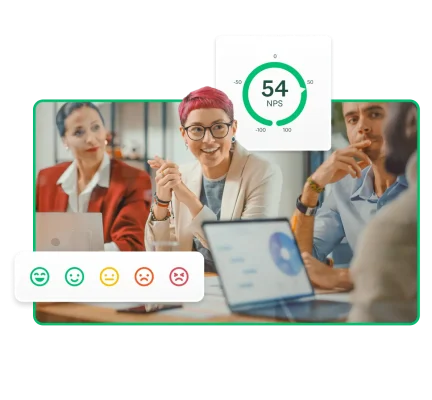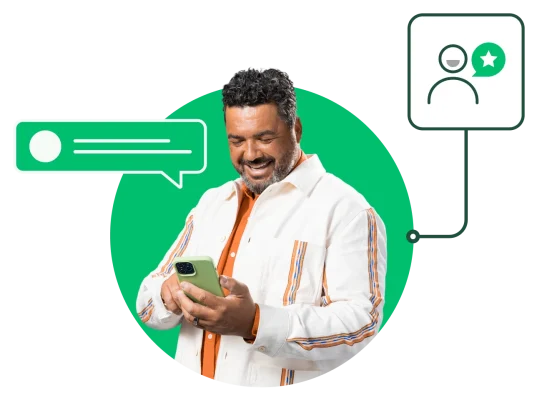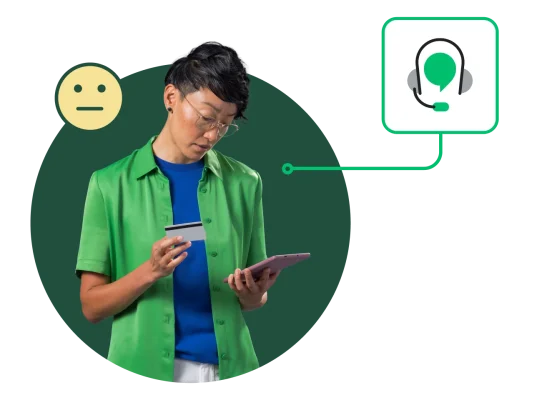How to respond to customer feedback (with examples)
A customer feedback response guide for savvy business owners.

- Customers' opinions and insights about their experiences with a company’s products or services are customer feedback.
- Customer feedback is invaluable as it can help you improve your products or services and increase customer satisfaction.
- It’s important to respond to feedback, both positive and negative, to show your concern and commitment to a positive customer experience and increase customer loyalty.
Positive or negative, when a customer shares feedback with you, it’s a gift. But many businesses don’t treat customer feedback as the gift it truly is.
This is a common mistake, and it happens often because both positive and negative feedback can be difficult to listen to. Gathering feedback is one thing; it’s another to use that feedback to improve the customer experience.
With customer feedback, you get to see your business through their eyes. That brief glimpse can completely change the course of the relationship. The direction it takes depends on how you handle the situation.
We’ve compiled a quick list of best practices for responding to customer feedback so you can make the most of it—whether glowing, scathing, or so-so.
Why you should respond to customer feedback
Responding to customer feedback, whether positive or negative, is a good practice to get in the habit of doing for several reasons:
- It shows you care. Responding to a customer’s feedback shows that you care about their feedback, whether positive or negative.
- It builds customer loyalty. Responding to your customers helps form deeper connections and builds brand loyalty. Consumers are more likely to make repeat purchases from a highly-engaged brand.
- It helps retain customers. Especially in the case of negative feedback, a timely response can turn a negative customer experience into a positive one. This can prevent your clients or customers from ending their business with you.
- It gives you a voice. When responding to customer feedback, you can express what your business stands for and apologize for lackluster experiences. This channel also allows you to voice the actions being taken to improve the customer experience.
Best practices for responding to customer feedback

Acknowledge feedback promptly
Your timeframe to engage a customer is slim. If you wait too long to follow up, it tells customers you don’t care or aren’t paying attention. That’s all an unhappy customer needs before they cancel services or post a negative review online.
Make it a point to respond to feedback within 24 to 48 hours. Just acknowledging feedback can buy you more time to repair the relationship. Plus, it shows the customer you’re ready and willing to do what it takes to retain them.
Even when dealing with positive feedback, it’s important to show customers appreciation when they take the time to praise you. Engaging with customers after a positive experience shows your gratitude and opens up more opportunities to build on their satisfaction.
Be respectful
It may seem like a no-brainer, but when reading particularly harsh feedback, it’s difficult not to take it personally and bring the heat. You’re human, after all. When you get punched, your first instinct may be to punch back.
But remember, customer feedback is not personal. It is the reality of doing business. When you get miffed while reading feedback, take a moment to check yourself. Make some tea. Take a deep breath. Give yourself a pep talk if you need to. And then respond respectfully.
Dig into the issue
A lot of customers leave vague feedback. For instance, they might say they had terrible service but not give any details. Was the wait time too long? Was a particular employee rude?
Make a point to get more information. First, do your homework. Consult with your team and check their customer history to determine what’s happening. If you can’t find answers, follow up with the customer for more information.
Continue the conversation
Addressing feedback quickly is important, but you don’t have to hold the entire conversation online. You’ll get more respect from a customer if you ask to hop on a call to discuss further. It shows initiative and reinforces that you want to resolve their issue above all else.
So, when an email exchange goes nowhere, switch it up and continue the conversation over the phone or in person.
How to respond to positive feedback with examples
Positive feedback is feedback from your customers that praises or names something they like about your products, services, or company. Examples of positive feedback include a customer survey that compliments your latest product or a response to your NPS® (Net Promoter Score®) survey in which a customer rates themselves a Promoter.
Hooray for happy customers! When a customer provides positive feedback, it’s cause for celebration. Before you break out the party hats, here are some best practices to consider:
- Express gratitude. First, say thanks. Tell the customer how much you appreciate their kind words. If the feedback concerns a specific person, tell the customer you’ll be sure to pass the praise along.
- Offer additional products or services. Customers thrilled with one of your products might like others, too. Subtly suggest an additional product the customer might like.
- Seize the opportunity. A customer who loves your product enough to sing its praises is an amazing asset. When you find one, consider asking them to write a testimonial for your website or refer their friends.
Positive customer feedback response example
Let’s say you own a custom jewelry company called XYZ Jewelry that creates unique pieces for customers in the United States. You recently received this piece of feedback from a happy customer.
“I am highly impressed with my topaz ring from XYZ Jewelry. The design process was super fun, and you really took my ideas to heart. Sheila was great to work with. Shipping was fast, and the ring was beautiful. I will be buying more pieces in the future!”
When responding to this customer feedback, you may reply with something along these lines:
“Thank you for your kind feedback. XYZ Jewelry is happy that you are satisfied with your purchase. We will pass your note to Sheila. We look forward to working with you again soon!”
How to respond to negative feedback with examples

Negative feedback is when customers provide criticism on what they don’t like about your company, customer service, or offerings. This can be a response to a feedback survey noting an issue with a product or an NPS survey where a customer rates themselves as a Detractor.
Every business, no matter how awesome, will get poor feedback at some point. Remain calm. Use these tips to handle negative feedback:
- Express concern. Tell the customer that you appreciate their feedback and are concerned about the treatment they received or the problem they’re facing.
- Restate the problem. When a customer is upset, they need to know they’ve been heard. The best way to show them you’re listening is to restate the problem in your own words. Do this before you propose any solution.
- Offer solutions. Ultimately, unhappy customers are just looking for answers, so get to the point quickly. When you can, present a solution in your first communication. If you can’t fix their problem, clearly explain why, then provide workarounds or instructions for what to do next.
- Take it offline. There will be times when it makes sense to take the conversation offline. Acknowledge the feedback, determine why the customer is upset, and offer a private conversation via email, chat, or phone to find a solution.
Negative customer feedback response example
For this example, imagine you run an auto repair shop called XYZ Auto. An unhappy customer shares this feedback in a recent survey you sent customers.
“I came to have my car repaired in June at XYZ Auto and was very disappointed with the customer service. Billy didn’t look up from his phone when I walked in the door, and he took a long time to notice I’d come inside. He was rude and dismissive when speaking to him about my car issue. Terrible service. Not to mention, my repair took longer than expected.”
It’s safe to say that this interaction rubbed this customer the wrong way. When responding to negative feedback like this, you may say something like:
“We’re sorry you didn’t have the best experience at XYZ Auto. We strive to provide the highest quality service to our customers. We would love to discuss your experience and see how we can improve our business. Give us a call during business hours at (XXX) XXX-XXXX.”
How to ask for feedback from customers
These positive and negative feedback examples are important. But how do you get that feedback from your customers in the first place? You can gather customer feedback throughout the feedback cycle in a few different ways.
You can use just one method or several to create a Voice of the Customer (VoC) program. Pick the right methods for your business's customer interactions, and you’ll gather plenty of great feedback in no time.
Feedback surveys
You can send your customers feedback surveys in many different forms—website surveys, product surveys, NPS surveys, Customer Satisfaction Score (CSAT) surveys, Customer Effort Score (CES) surveys, and so on. You can choose the survey that aligns with the feedback you want to collect. There’s a survey for every touchpoint in the customer journey.
All you need to do is select the survey that works for your goals, find the right CX solution (like SurveyMonkey), build your survey, and send it to customers. Then, watch the positive and negative feedback roll in. Surveys can be as short as one multiple-choice question, include open-ended questions, or several questions to gather additional feedback.
Contact forms
An easy-to-use contact form on your website means customers can reach out quickly with any issues or problems. It puts the power in their hands to access your customer service team when a problem arises. Relying only on feedback mechanisms where you reach out to customers can lead to frustration when an issue arises and a customer can’t contact you.
Customer forms
Customer forms play a crucial role in understanding customer opinions. They provide a platform to connect with customers and solicit their views on your products or services, customer service team, and company.
These forms can be a great way to get feedback from customers who like your company but aren’t ardent enough fans to leave reviews. Customer forms can also help you dig deeper into issues or strengths you’ve identified via other feedback mechanisms and find out in more detail what customers think.
Live chat
Convenience is key for consumers, which explains the growing popularity of live chat options on business websites. These chatbots allow customers to get help with minor issues in a timely manner. They can also be programmed to ask for feedback after a customer performs an action, like making a purchase or paying a bill.
Since live chat is a low-touch option, many customers too busy to complete a survey may be willing to click one button to give you a quick star rating. The downside is that you’ll miss out on thoughtful, open-ended feedback that can help you get to the root cause of problems.
Frequently asked questions
How to respond to private customer feedback?
Be kind and courteous when responding to private customer feedback, such as an email sharing a customer's negative experience with a retail employee. Ensure that you express concern, restate the problem, offer a solution, and take it offline if need be.
Remember, this is your chance to turn a negative customer experience into a positive one. So, make it count!
How to respond to public customer feedback?
When a customer leaves feedback in a public forum such as Google Reviews or Yelp, respond promptly, regardless of whether the feedback is positive or negative. In the case of a glowing review, take the time to thank the customer for sharing their experience and being a loyal customer.
This helps further develop a strong customer relationship that can help bring new customers to your business.
Learn how SurveyMonkey can help you exceed customers’ expectations—sign up for FREE.
Net Promoter, Net Promoter Score, and NPS are trademarks of Satmetrix Systems, Inc., Bain & Company, Inc., and Fred Reichheld.
Discover more resources

Customer satisfaction survey templates
Explore our customer satisfaction survey templates to rapidly collect data, identify pain points, and improve your customer experience.

C-suite secrets: Smart strategies for tough times
Hear from industry leaders on how they're facing current business challenges and driving impact

Voice of the cruiser: Hornblower's CX playbook
How to use feedback to create an impactful cx program

Inspired by you, powered by AI: A reimagined SurveyMonkey experience
Webinar about SurveyMonkey platform updates